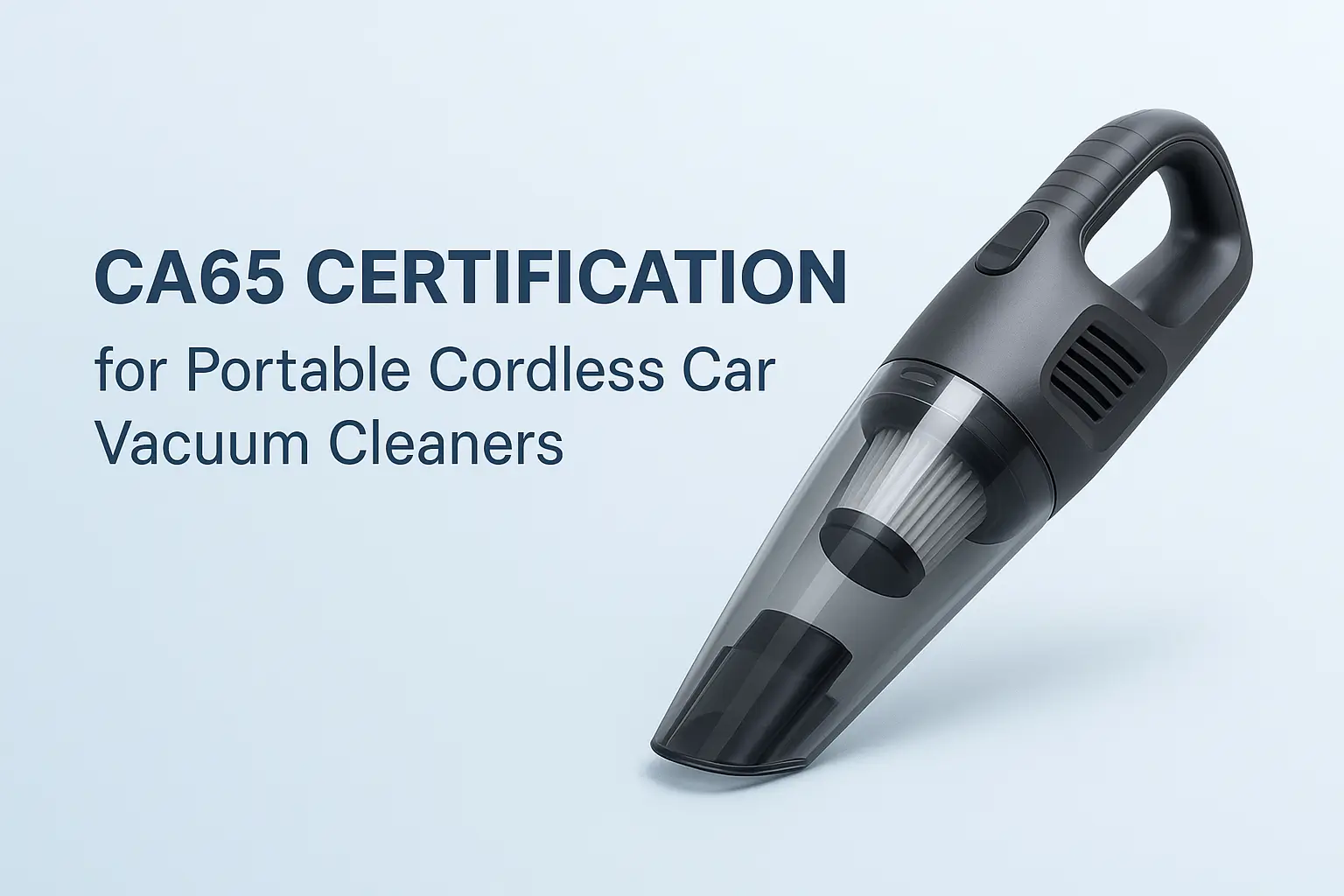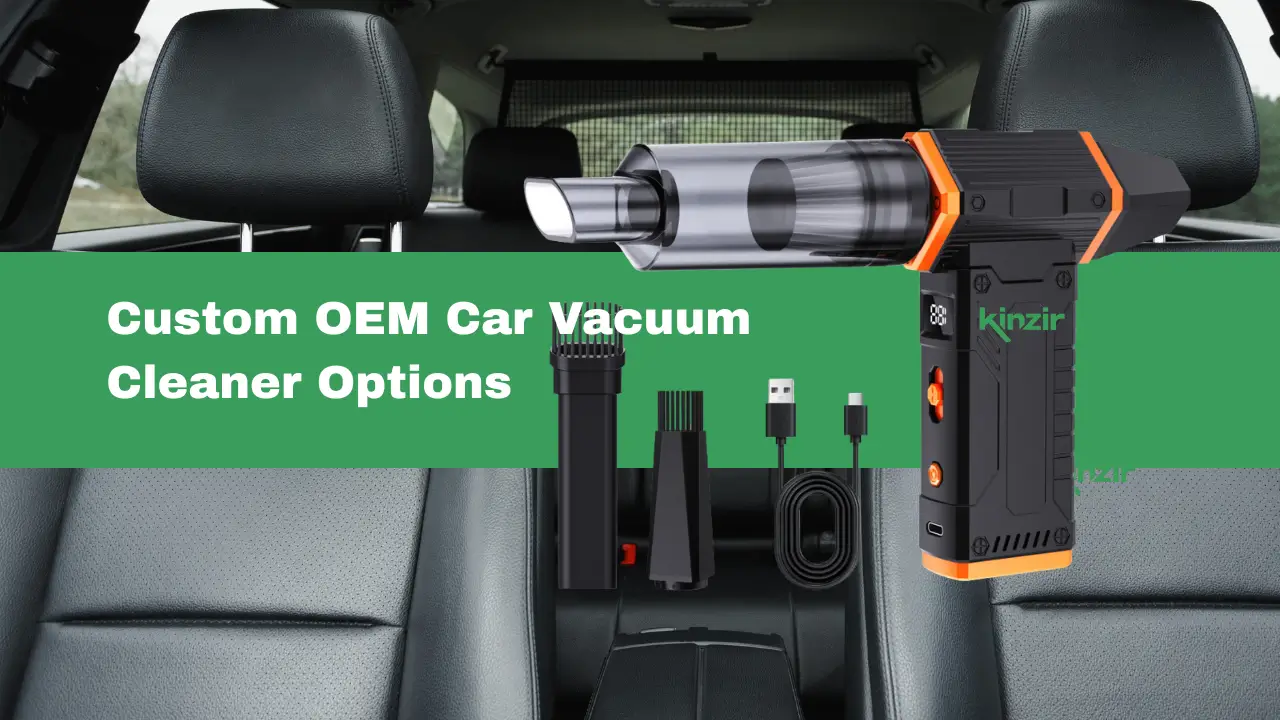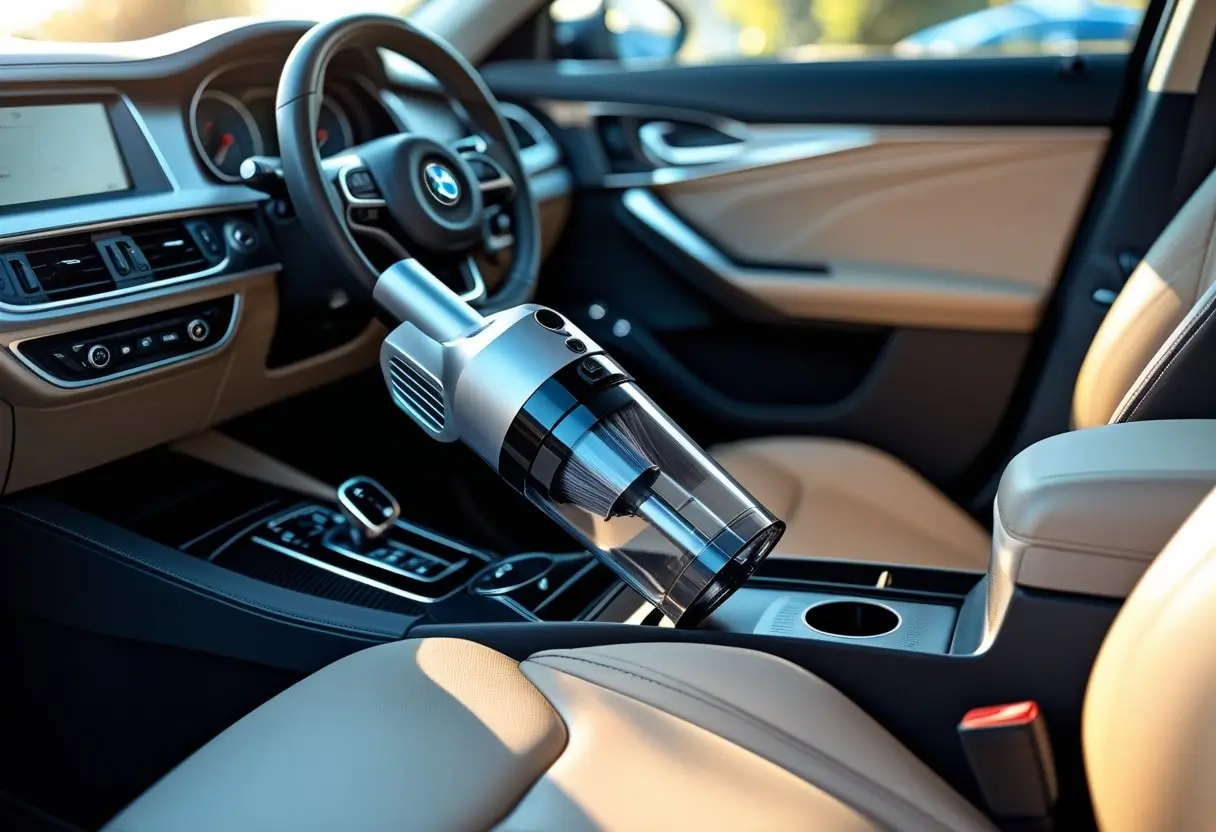Keeping your digital devices clean and well-maintained is crucial for optimal performance and longevity. Electric air dusters offer a convenient, eco-friendly solution compared to traditional canned air. In this guide, we’ll explore the top 10 uses of electric air dusters that can revolutionize your cleaning routine.

Electric air dusters are powerful tools that provide continuous airflow without harmful chemicals or the environmental impact of disposable cans. You’ll find these versatile devices indispensable for everything from computer maintenance to household cleaning tasks.
As a leading supplier of premium electric air dusters, Kinzir understands how these devices can simplify your life. Our durable, high-performance models deliver professional-grade cleaning power right to your fingertips, making dust and debris removal effortless across multiple applications.
Computer Cleaning
Electric air dusters provide a powerful, eco-friendly solution for keeping your computer clean and running efficiently. They offer precise control for removing dust from delicate components while being safer than traditional canned air alternatives.
Removing Dust From Internal Components
Electric air dusters excel at cleaning hard-to-reach internal computer components. Before cleaning, always shut down your computer and unplug all power sources for safety.
When cleaning your motherboard, CPU heat sink, and RAM, hold the air duster 2-3 inches away to prevent static discharge. Move methodically from top to bottom of your case. For best results, use short bursts rather than continuous airflow.
Key components to focus on:
- CPU cooler and heat sink
- RAM slots and modules
- GPU fans and heatsinks
- Power supply vents
- Motherboard crevices
Use a small brush attachment for stubborn dust in tight spaces. Electric dusters are particularly effective for removing dust from fans without causing damage that can occur when using compressed air.
Cleaning Vents And Air Intakes
Your computer’s vents and air intakes are critical pathways for cooling. When clogged with dust, they restrict airflow and increase internal temperatures. Electric air dusters make this maintenance task quick and efficient.
For laptop vents, use the low or medium setting to avoid damaging delicate components. Hold the duster at a 45-degree angle for most effective dust removal. Clean vents from both directions when possible – blow from inside out, then outside in.
Desktop computers typically have larger vents that can collect significant dust. Focus on:
- Front panel intakes
- Rear exhaust vents
- Side panel vents
- Top case vents (if present)
Regular cleaning of these areas every 1-3 months helps maintain optimal airflow and prevents dust accumulation inside your system.
Preventing Overheating Issues
Dust buildup is the primary cause of computer overheating. Electric air dusters help maintain optimal operating temperatures and extend your computer’s lifespan.
Warning signs of dust-related overheating:
- Unexpected shutdowns
- Performance throttling
- Louder than normal fan noise
- System crashes during resource-intensive tasks
Clean your CPU cooler thoroughly, as it’s particularly susceptible to dust accumulation. For liquid cooling systems, focus on radiator fins where dust easily collects. Graphics cards need special attention too, as their cooling systems can become severely compromised by dust.
Set a regular cleaning schedule based on your environment. Households with pets, smokers, or high dust levels may require monthly cleaning. Creating a maintenance calendar reminds you to perform this essential task before overheating becomes problematic.
Best Practices For Safe Computer Cleaning
Electric air dusters offer safety advantages over compressed air cans, but proper technique remains essential. Always work in a well-ventilated area to avoid breathing in the displaced dust particles.
Hold fans in place while cleaning to prevent them from spinning too fast, which can damage bearings or generate unwanted electrical current. For particularly dirty systems, consider taking your cleaning outdoors or use a dust mask.
Essential safety tips:
- Never use electric dusters on wet components
- Avoid touching nozzles to sensitive electronics
- Keep the duster moving rather than concentrating on one spot
- Wait 5-10 minutes after cleaning before powering up your system
Pair your electric air duster with microfiber cloths for screen cleaning and isopropyl alcohol (90%+) for removing stubborn grime from non-electronic surfaces. This combination creates a comprehensive, eco-friendly computer maintenance routine that’s both effective and sustainable.
Keyboard Cleaning
Electric air dusters excel at cleaning keyboards, providing powerful yet safe airflow to remove debris without damaging sensitive components. They reach areas that traditional cleaning methods simply cannot access, making them indispensable for proper keyboard maintenance.
Eliminating Crumbs, Dust, And Debris Between Keys
Keyboards collect surprising amounts of dust, crumbs, and debris during daily use. These particles settle between and beneath keys, affecting performance and potentially causing permanent damage. Electric air dusters provide precise, powerful airflow that dislodges these particles effectively.
For best results, hold your keyboard at a 75-degree angle while cleaning. This positioning allows gravity to assist as you blow debris out rather than deeper into the keyboard mechanism.
Key benefits of using electric air dusters for debris removal:
- Consistent air pressure unlike canned air that diminishes quickly
- No harmful chemicals or propellants
- Reaches deep between keys where wipes cannot access
- Prevents buildup that can lead to sticky keys and malfunctions
Proper Technique For Keyboard Maintenance
Start by turning off your keyboard and disconnecting it from power sources. This precaution prevents potential electrical issues and accidental keystrokes during cleaning.
Hold the electric air duster approximately 1-2 inches from the keyboard surface. Begin at one corner and work methodically across in rows, ensuring you cover the entire keyboard.
Use short, controlled bursts rather than continuous airflow. This technique prevents simply moving debris from one section to another.
For stubborn debris, try approaching from different angles. Sometimes changing the direction of airflow can dislodge particles that resist initial cleaning attempts.
Maintain a regular cleaning schedule—weekly for heavy users, monthly for average users—to prevent excessive buildup that becomes difficult to remove.
Preventing Key Sticking And Malfunction
Regular cleaning with an electric air duster significantly reduces the risk of key sticking and malfunction. When dust and debris accumulate under keys, they interfere with the keyboard’s mechanical or membrane switches.
Warning signs your keyboard needs cleaning:
- Keys sticking or requiring extra pressure
- Inconsistent response when typing
- Strange clicking or crunching sounds during use
- Keys remaining depressed after typing
Beyond preventative maintenance, electric air dusters can resolve existing issues. For keys already showing signs of sticking, focus additional attention on the problematic areas.
For mechanical keyboards, use the duster’s precision nozzle to target individual switch mechanisms. For membrane keyboards, clean around the edges of keys where dust typically accumulates.
Compatibility With Different Keyboard Types
Electric air dusters work effectively with all keyboard types, but proper technique varies slightly between them. For mechanical keyboards with removable keycaps, consider removing some keycaps for deeper cleaning of switch mechanisms.
Laptop keyboards benefit tremendously from electric dusters, as their compact design makes them particularly vulnerable to debris damage. Use lower power settings when cleaning laptop keyboards to avoid damaging delicate components.
Wireless keyboards require special attention around battery compartments and connection points. Ensure these areas remain clean for optimal performance and connectivity.
Gaming keyboards with RGB lighting need regular maintenance to prevent dust from dulling illumination. Direct the duster at light openings to maintain vibrant, even lighting across all keys.
Standard membrane keyboards are the most straightforward to clean, but still benefit from regular maintenance with an electric duster to extend their functional lifespan.
Home And Office Use
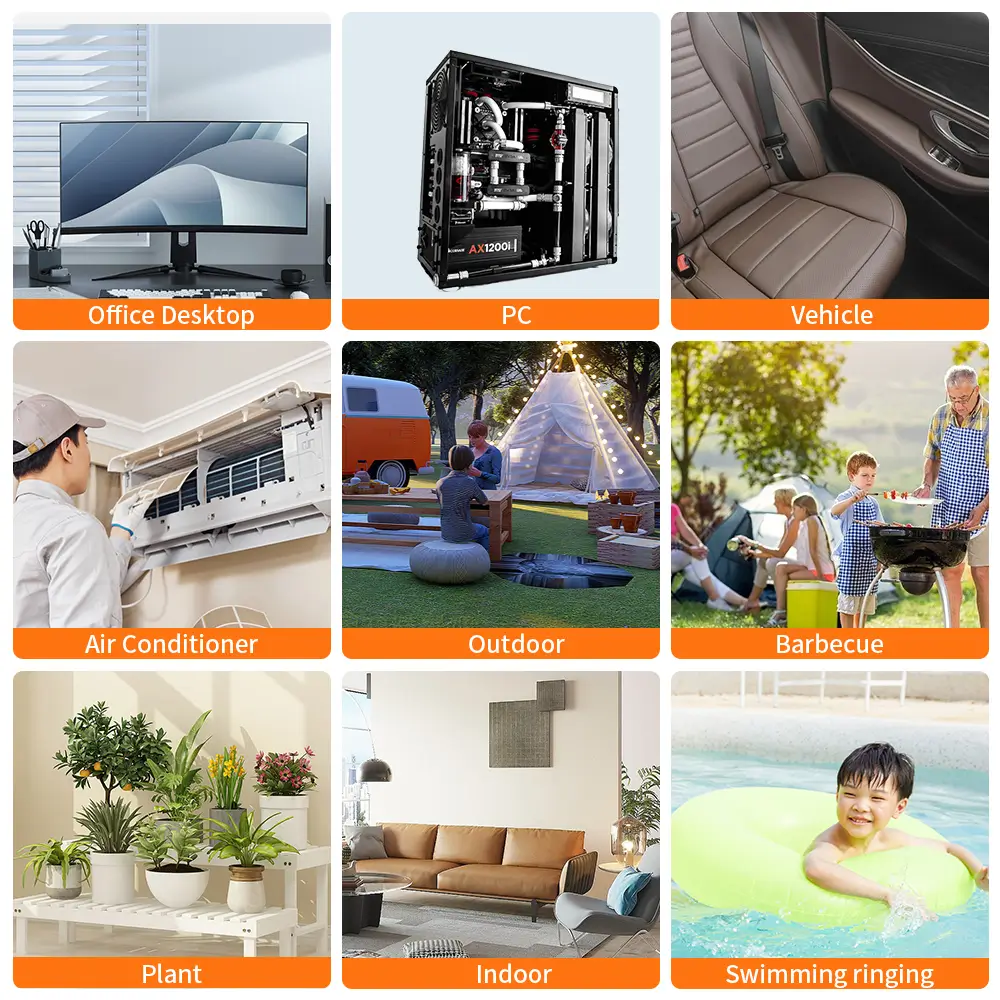
Electric air dusters shine brightest when applied to everyday cleaning tasks around homes and offices. These versatile tools provide precise, powerful streams of air that reach spaces where traditional dusters and cloths cannot go.
Cleaning Electronic Devices
Electronic devices collect dust and debris in their ports, vents, and keyboards, which can lead to overheating and premature component failure. Your electric air duster excels at removing these particles without the moisture risks associated with cleaning sprays.
For keyboard cleaning, hold the duster at a 45-degree angle and use short, controlled bursts between the keys to dislodge crumbs and dust. This prevents debris from being pushed deeper into the device.
Computer fans and heat sinks require regular cleaning to maintain optimal performance. Direct the air stream through ventilation slots while holding the fan blades steady to prevent damage from excessive spinning.
Gaming consoles and media players benefit from monthly maintenance with your electric duster. Focus on ventilation openings and connection ports where dust accumulation is most problematic.
Dusting Delicate Items
Collectibles, figurines, and other delicate items often gather dust in hard-to-clean crevices. Electric air dusters provide gentle yet effective cleaning without physical contact that might cause damage.
For bookshelves containing valuable books or fragile ornaments, adjust your duster to a lower pressure setting. Work from top to bottom, directing dust downward where it can be vacuumed afterward.
Photography equipment demands special care. Use your electric duster to clean camera bodies, lens exteriors, and especially the lens mount area. Always maintain a safe distance of at least 4 inches to prevent any potential damage.
Antique items with intricate details benefit from the precision of electric dusters. The focused airstream reaches tiny grooves and ornate features that cloth dusters might miss or damage.
Cleaning Blinds, Vents, And Hard-To-Reach Areas
Window blinds collect substantial dust but are notoriously difficult to clean. Your electric duster makes this task simpler by blowing dust away without the tedious wipe-down process. Close the blinds and work from top to bottom, alternating sides for thoroughness.
HVAC vents and return registers harbor dust that can affect air quality. Remove the vent covers and use your duster to clean both the visible surfaces and deeper into the ductwork. This improves airflow and reduces allergens in your environment.
Ceiling fans and light fixtures become dust magnets over time. Use your electric duster with an extension nozzle to reach these heights safely, avoiding the need for ladders in many cases.
| Area | Cleaning Frequency | Duster Setting |
|---|---|---|
| Keyboards | Weekly | Low-Medium |
| HVAC Vents | Monthly | Medium-High |
| Ceiling Fans | Bi-monthly | Medium |
| Collectibles | As needed | Low |
Routine Maintenance Tips For A Cleaner Environment
Establish a regular cleaning schedule using your electric air duster for optimal results. Weekly maintenance prevents excessive buildup and makes each cleaning session quicker and more effective.
Keep your electric duster charged and accessible. Many users find that storing the tool in a central location encourages more frequent use for quick touch-ups.
Use appropriate attachments for specific tasks. Brush attachments work well for fabric surfaces, while precision nozzles excel at detailed work around electronics.
Always clean from top to bottom in any room. This natural approach to dust settlement ensures you’re not redistributing particles to already-cleaned areas.
Pair your electric duster with a HEPA vacuum for the most effective cleaning routine. The duster dislodges dust while the vacuum captures it, preventing it from settling elsewhere.
Car Interior Cleaning
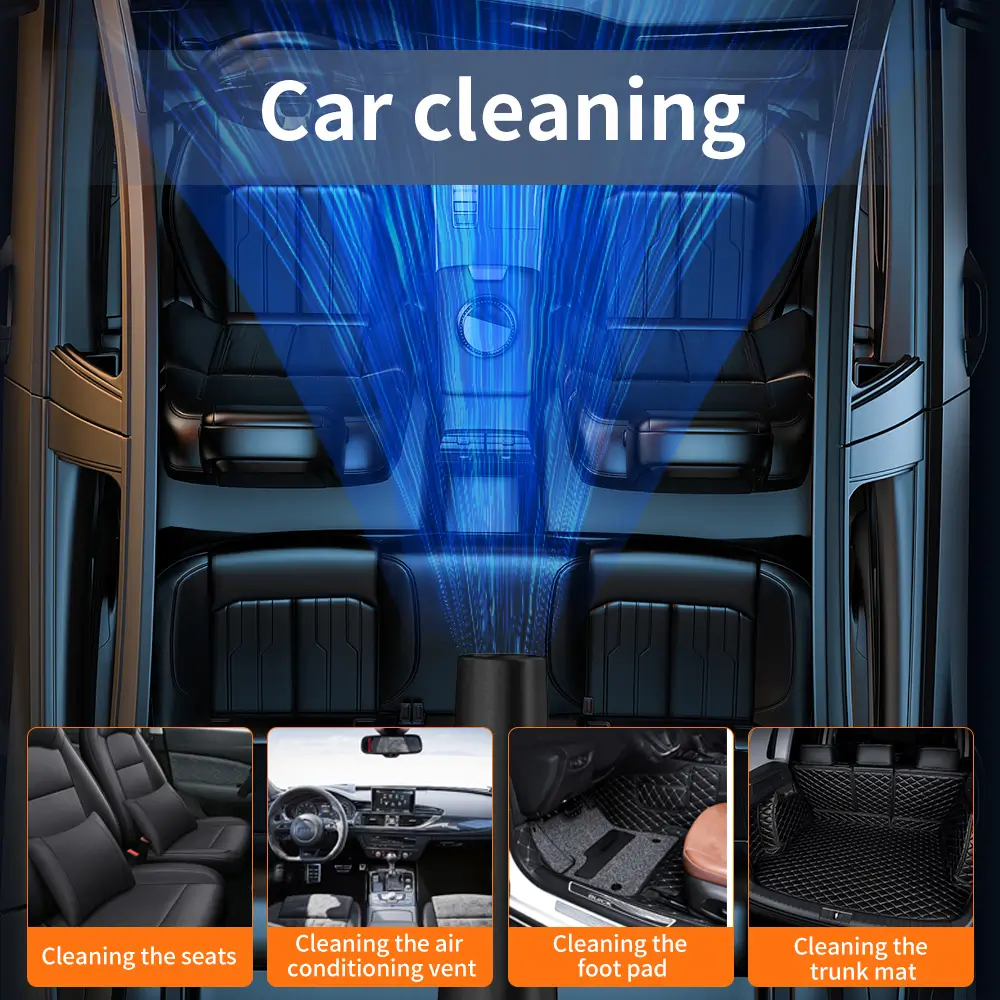
Electric air dusters provide powerful cleaning solutions for car interiors without the mess of traditional cleaning methods. They deliver concentrated air precisely where needed, making them invaluable for automotive detailing enthusiasts and everyday drivers alike.
Reaching Tight Spaces In Dashboards And Control Panels
Dashboard control panels feature numerous tiny crevices that accumulate dust and debris over time. Electric air dusters excel at blasting away particles from buttons, knobs, and display screens without risking damage to electronic components.
Position the duster’s nozzle at a 45-degree angle to target dust without pushing it deeper into controls. For extra precision, attach the included narrow extension tip to reach between steering column controls and around gear shifters.
Pro tip: Before using the air duster, close all vents to prevent redistributing dust throughout the cabin. Work from top to bottom, starting with upper dashboard areas and finishing with lower console regions.
For touchscreens and digital displays, use short, controlled bursts rather than continuous airflow to prevent potential static electricity issues.
Cleaning Air Vents And AC Systems
Air vents harbor significant dust deposits that can affect cabin air quality and system efficiency. Electric air dusters provide enough power to dislodge embedded particles from vent slats and internal ducts.
For best results, turn your AC to maximum before cleaning to help loosen debris. Direct the nozzle between each vent blade, working methodically across all dashboard and side vents.
Important safety note: Always run your car’s AC system for 5-10 minutes after cleaning vents to clear any dislodged particles from deeper in the system.
For circular vents, use a rotating motion while applying short bursts of air to clean around the entire circumference. This technique prevents dust from simply relocating to another part of the vent system.
Many modern electric dusters feature adjustable pressure settings – use lower settings for delicate vent components and higher settings for stubborn buildup.
Removing Debris From Seats And Upholstery
Vehicle upholstery collects crumbs, dust, and debris in seams and crevices that vacuum cleaners often miss. Electric air dusters effectively force out particles from tight spaces between seat cushions and backrests.
Begin by sweeping the duster across fabric surfaces to loosen embedded dust. Then concentrate on seams, piping, and seat tracks where debris accumulates most heavily.
For leather upholstery: Use gentle air pressure and keep the nozzle 2-3 inches away to prevent cracking or drying the material. Follow up with appropriate leather conditioner.
For stubborn debris in seat rails and adjustment mechanisms, use the focused stream attachment and short bursts of air. This prevents grit from interfering with smooth seat operation while extending mechanism lifespan.
Compressed air works exceptionally well for cleaning child car seat attachments and safety buckle mechanisms that may become clogged with crumbs or dirt.
Tips For Efficient Car Interior Maintenance
Establish a regular car cleaning schedule using your electric air duster every 2-3 weeks to prevent dust buildup. This proactive approach makes each cleaning session faster and more effective.
Essential maintenance routine:
- Start with air dusting before vacuuming
- Work from top (headliner) to bottom (floor mats)
- Use appropriate attachments for different areas
- Clean air filter of the duster after each use
Consider wearing a dust mask during extensive cleaning sessions, as electric dusters can temporarily aerosolize fine particles. Open car doors or windows to improve ventilation while cleaning.
For travel convenience, choose a rechargeable model with at least 30 minutes of continuous operation. Keep your duster in the trunk with other car cleaning supplies for quick touch-ups wherever you go.
Match air pressure to the task – use lower settings for delicate electronics and maximum power for deeply embedded dirt in carpets and floor mats.
Air Conditioning Cleaning
Electric air dusters provide a powerful and effective way to maintain your air conditioning system without the use of chemicals or water that could damage sensitive components. They deliver precision cleaning that extends the life of your AC units while improving their performance.
Removing Dust From Filters And Vents
Dust accumulation in AC vents and filters is inevitable but easy to address with an electric air duster. Begin by turning off your air conditioning system completely to prevent circulation of disturbed dust. Remove the vent covers and filters according to your manufacturer’s instructions.
Hold the electric duster 2-3 inches away from the filter surface and use short, controlled bursts to dislodge dust. Work methodically from top to bottom and from the center outward. For stubborn buildup, increase the pressure slightly but maintain distance to avoid damaging the filter material.
For vents, direct the nozzle between the slats where dust typically collects. The narrow nozzle attachments that come with most electric dusters are perfect for reaching these tight spaces. Remember to clean both supply and return vents for optimal airflow.
Improving Air Quality And System Efficiency
Regular cleaning with an electric air duster dramatically improves your AC system’s efficiency. When dust and debris block airflow, your system works harder, consuming more energy and delivering less cooling power.
Energy Savings: Clean AC systems use 5-15% less energy than dirty ones, according to the U.S. Department of Energy. This translates to noticeable savings on your utility bills.
Performance Benefits:
- Faster cooling times
- More consistent temperatures
- Reduced strain on system components
- Extended equipment lifespan
Use your electric duster to clean not just filters but also the condenser coils and fan blades. These critical components perform best when free of dust. For coils, use a gentle setting and maintain a safe distance to avoid bending the delicate fins.
Preventing Allergen Buildup
Your AC system can become a collection point for allergens such as pollen, pet dander, and dust mites. Electric air dusters provide a non-chemical way to remove these irritants before they circulate throughout your home.
Focus on cleaning the return air ducts where allergens first enter your system. Use your duster’s highest setting for deep cleaning these areas quarterly. For households with allergy sufferers, monthly cleaning may be necessary during high pollen seasons.
Pay special attention to the blower compartment, where allergens can accumulate and be distributed throughout your ductwork. Remove the access panel (after disconnecting power) and use your electric duster to clean the blower wheel and surrounding housing.
After cleaning, consider installing high-efficiency filters that capture more allergens. Remember to clean these regularly with your electric duster to maintain their effectiveness.
Maintenance Schedule Recommendations
For optimal AC performance, establish a regular cleaning schedule using your electric air duster. Basic filter cleaning should occur monthly during heavy-use seasons (summer and winter).
Seasonal Cleaning Checklist:
| Component | Frequency | Technique |
|---|---|---|
| Air filters | Monthly | Medium pressure, short bursts |
| Vents and registers | Quarterly | Low pressure, targeted cleaning |
| Condenser coils | Bi-annually | Low pressure, wide sweeping motion |
| Blower assembly | Annually | Medium pressure, detailed cleaning |
Mark these maintenance dates on your calendar or set smartphone reminders. Many homeowners find it helpful to clean their AC system at the beginning of each season.
Between deep cleanings, use your electric duster for quick touch-ups when you notice visible dust on vents. This prevents buildup and maintains consistent air quality throughout your home.
Camping And Outdoor Activities

Electric air dusters prove invaluable for outdoor enthusiasts by keeping gear clean and functional while away from home. Their portable nature and versatility make them essential tools for maintaining equipment in outdoor settings where dirt, sand, and debris are constant challenges.
Cleaning Camping Gear And Equipment
Cordless air blowers excel at maintaining camping equipment in pristine condition during your adventures. You can quickly remove pine needles, leaves, and dirt from tent floors and rain flies before packing them away. This prevents abrasive particles from causing premature wear or damage to your gear.
For sleeping bags and pads, a quick blast from a rechargeable air duster removes crumbs and debris that might otherwise lead to uncomfortable nights. The concentrated airflow reaches into corners and seams where brushing alone cannot.
Cooking equipment benefits greatly from air duster cleaning. You can remove ash and food particles from portable stoves, cooking utensils, and mess kits without using water—especially valuable when water supplies are limited during camping trips.
Removing Sand And Dirt From Outdoor Accessories
Beach camping presents unique challenges with sand infiltrating everything. Your electric air duster becomes essential for cleaning sand from binoculars, camera equipment, and other sensitive gear where abrasive particles could cause damage.
Hiking boots and footwear can be quickly cleaned before entering your tent or vehicle. A few strategic blasts of air remove trail dust and debris from treads and seams.
Portable chairs, tables, and other camp furniture accumulate dirt in joints and fabric seams. You can extend their lifespan by regular cleaning with your air duster.
Common outdoor items to clean with air dusters:
- Backpacks (zippers, pockets, seams)
- Fishing gear (reels, tackle boxes)
- Climbing equipment (carabiners, harnesses)
- Mountain bikes (chains, gears, brakes)
Quick Cleanup Of Portable Electronics
Your camping experience often includes electronics that need protection from the elements. Rechargeable air dusters provide gentle yet effective cleaning for devices like GPS units, satellite phones, and action cameras.
Solar chargers function more efficiently when dust-free. You can maintain optimal performance by regularly cleaning panels with your portable air duster.
Headlamps and flashlights benefit from air duster maintenance, particularly around battery compartments and switches where moisture and dirt might otherwise cause corrosion or malfunction.
Weather stations, portable speakers, and e-readers all require protection from environmental elements. Quick, regular cleaning with your electric air duster prevents dirt buildup that could otherwise lead to performance issues.
Power Options When Using Outdoors
Modern rechargeable air dusters offer several power solutions for extended outdoor use. Many models include USB charging capabilities, allowing you to recharge them using portable power banks or solar chargers.
Some high-capacity models provide several hours of operation on a single charge—ideal for weekend camping trips. Look for models with battery level indicators to avoid unexpected power loss.
Power source comparison for outdoor use:
| Power Source | Advantages | Considerations |
|---|---|---|
| Built-in rechargeable | Lightweight, no extra batteries | Requires recharging access |
| Solar compatible | Sustainable power source | Weather dependent |
| USB charging | Universal compatibility | Needs power bank or vehicle |
| Replaceable battery | Quick swap capability | Extra weight from spare batteries |
For longer expeditions, consider models with replaceable battery packs. This allows you to bring backups for extended time away from charging sources.
Barbecue And Grill Maintenance

Electric air dusters provide powerful, precise cleaning capability for maintaining your barbecue and grill equipment. They reach areas traditional cleaning tools cannot access while offering a chemical-free alternative to keep cooking surfaces sanitary and functioning optimally.
Clearing Ash And Debris From Grills
Electric air dusters excel at removing loose ash and debris from your grill surfaces without the mess of traditional cleaning methods. Simply disconnect your grill from power sources and ensure it’s completely cool before beginning.
Direct the air duster nozzle at accumulated ash deposits around burners, heat deflectors, and the bottom of your grill chamber. The concentrated airflow dislodges stubborn particles without scratching delicate surfaces.
For charcoal grills, use short bursts to clean ash collection trays and ventilation holes. This prevents airflow blockages that can affect cooking temperatures and performance.
Regular ash removal using an electric air duster prevents buildup that can trap moisture and accelerate corrosion. This extends your grill’s lifespan and maintains consistent cooking results.
Pro tip: Use the air duster before and after grilling season for thorough maintenance. Cover your work area with a drop cloth to contain displaced ash and make cleanup easier.
Cleaning Hard-To-Reach Areas Between Grates
Grill grates develop carbon deposits and food residue in their joints and crevices that brushes often cannot reach. Electric air dusters provide the precision needed to clean these difficult areas effectively.
Begin by removing grates from the grill and brushing off loose debris. Target the air duster at intersections and underneath cross-sections where grease accumulates.
For cast iron grates, use the air duster to remove loose rust particles after scrubbing with a wire brush. This prevents rust particles from contaminating food during your next cookout.
Cleaning sequence for best results:
- Brush grates with grill brush
- Apply appropriate cleaner
- Use air duster in crevices
- Rinse thoroughly
- Dry completely with air duster
This technique is particularly valuable for maintaining stainless steel and porcelain-coated grates where abrasive cleaning methods might cause damage to protective surfaces.
Maintenance Of Electric Components
Modern grills often feature electric components like ignition systems, temperature controllers, and LED displays that require special cleaning attention. Electric air dusters provide safe, dry cleaning for these sensitive parts.
Disconnect all power sources before cleaning any electrical components. Focus on control panels, ignition button housings, and temperature probe connections where grease and moisture can accumulate.
Use gentle, controlled bursts to avoid damaging delicate wiring. The air duster’s precision nozzle helps remove dust and debris from circuit boards without creating static electricity risks.
For rotisserie motors and connections, an air duster removes the grime that can cause mechanical failure. Pay special attention to ventilation slots that keep these components from overheating.
Warning: Never use liquid cleaners on electrical components. The electric air duster provides a completely dry cleaning method that won’t short-circuit sensitive electronics.
Safety Considerations When Cleaning Cooking Equipment
Always ensure your grill is completely cool before using an electric air duster. Metal surfaces can retain heat for hours after cooking, creating burn hazards during cleaning.
Wear eye protection when operating the air duster to shield against dislodged particles. A dust mask prevents inhalation of fine ash and debris that becomes airborne during cleaning.
Disconnect propane tanks or natural gas lines before thorough maintenance. This eliminates leak risks if you accidentally dislodge gas fittings during the cleaning process.
Use the air duster in well-ventilated areas, preferably outdoors. This prevents concentrated dust clouds and ensures proper dispersion of airborne particles.
Avoid directing the air duster at areas with loose insulation or fire box liners. The powerful airstream can damage these materials or create gaps in thermal barriers.
Clean your electric air duster regularly according to manufacturer instructions. Grease accumulation within the tool can affect performance and potentially become a fire hazard over time.
Ball Inflation

Electric air dusters provide a convenient solution for inflating sports balls efficiently and precisely. They offer consistent pressure control and require less physical effort than traditional methods.
Proper Techniques For Inflating Various Sports Balls
When inflating a basketball, insert the needle at a slight angle while the ball is at room temperature for optimal results. Hold the electric duster firmly against the valve to prevent air leakage.
For footballs, moistening the needle slightly helps with insertion and reduces potential valve damage. Apply steady pressure with your electric air duster rather than short bursts.
Soccer balls require careful inflation to manufacturer specifications, typically 8.5-15.7 PSI. Your electric duster’s pressure control feature helps achieve this precision.
Tennis and volleyball inflation demands gentler handling. Use your electric duster on a lower setting to gradually add air until you reach the proper bounce height or firmness.
Appropriate Attachments To Use
Standard needle attachments work for most sports balls but specialized options improve efficiency. Select stainless steel needles over plastic for durability and better seal formation.
Recommended Attachments:
- Ball needle adapter (universal fit)
- Pressure gauge attachment
- Fine-control nozzle for smaller balls
- Extended reach adapter for deep valves
Multi-needle kits allow you to keep dedicated needles for different ball types, reducing cross-contamination and wear. Some electric dusters include specialized sports inflation kits.
Pressure measurement attachments connect directly to your duster for real-time PSI monitoring. This eliminates guesswork and ensures consistent results across all ball types.
Pressure Control Tips
Adjust your electric duster’s pressure settings before beginning inflation. Most sports balls require between 7-15 PSI, but check manufacturer specifications for exact requirements.
Pressure Recommendations:
| Ball Type | PSI Range |
|---|---|
| Basketball | 7.5-8.5 |
| Football | 12.5-13.5 |
| Soccer | 8.5-15.7 |
| Volleyball | 4.3-4.6 |
Inflate in short bursts rather than continuous streams to better control pressure. Check firmness frequently during inflation to avoid over-pressurizing.
Temperature affects pressure readings—balls inflated in cold environments will increase in pressure when brought to warmer conditions. Account for this by slightly under-inflating in cold weather.
Advantages Over Manual Pumps
Electric air dusters provide consistent pressure throughout the inflation process, unlike manual pumps that deliver decreasing force as you tire. This results in more evenly inflated balls.
The precision control offered by electric options reduces the risk of over-inflation, which can damage expensive sports equipment. Many models include automatic shut-off at target pressures.
You’ll save significant time when inflating multiple balls for team practices or events. What might take 30 minutes with a hand pump can be completed in under 5 minutes with an electric duster.
Electric dusters require no physical exertion, making them ideal for coaches, teachers, or anyone with hand strength limitations. The ergonomic design prevents the hand fatigue associated with manual pumping.
Inflatable Products
Electric air dusters excel at inflating various products quickly and efficiently. Their powerful airflow makes them versatile alternatives to traditional pumps for many household inflatable items.
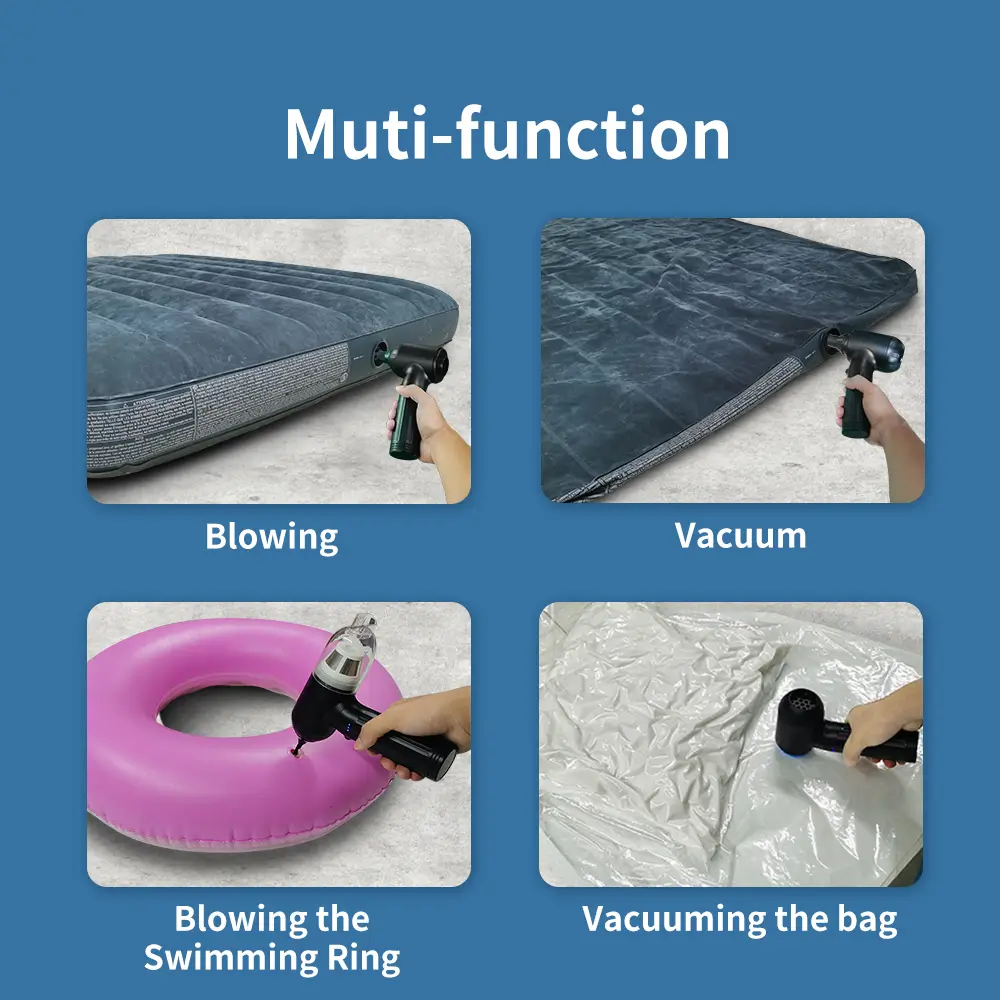
Inflating Swimming Rings And Pool Accessories
Electric air dusters provide an excellent solution for inflating pool toys when you don’t have a dedicated pump available. Simply attach the nozzle to the valve of your swimming ring or float and activate the duster. The concentrated airflow fills most small to medium-sized pool accessories in under a minute.
For best results, hold the air duster nozzle firmly against the inflation valve to prevent air leakage. Many electric dusters come with valve adapters that create a better seal, maximizing efficiency.
You can inflate multiple items in succession without waiting for the duster to recover, unlike with manual pumps that require rest periods. This capability makes electric air dusters particularly valuable during pool parties or beach outings when numerous inflatables need quick preparation.
Setting Up Air Mattresses And Beds Quickly
An electric air duster can significantly reduce the time needed to inflate air mattresses and temporary beds. While not as powerful as dedicated air mattress pumps, dusters work well for emergency situations or when traveling without specialized equipment.
To use effectively, select the appropriate nozzle adapter that fits your mattress valve. Most standard air dusters can inflate a twin-sized air mattress in 3-5 minutes. Larger mattresses may require more time but still inflate much faster than manual methods.
The precision control offered by electric dusters allows you to stop at exactly the desired firmness. This advantage makes them ideal for adjusting partially inflated mattresses without the risk of overinflation.
Tips For Achieving Proper Inflation Levels
When using an electric air duster for inflatable products, start with short bursts rather than continuous airflow. This technique gives you better control over the inflation level and prevents accidental overinflation.
For items requiring precise pressure levels, consider using a pressure gauge between inflation sessions. Many premium electric dusters include built-in pressure indicators that help achieve optimal results.
Temperature affects inflation significantly – items inflated in cool environments may expand when exposed to heat. Leave approximately 10% capacity uninflated if the item will be used in a warmer setting than where it’s being inflated.
Always check the manufacturer’s specifications for both your air duster and the inflatable product. Some delicate inflatables may specify maximum pressure limits that electric dusters could potentially exceed.
Time-Saving Benefits Compared To Manual Methods
Electric air dusters typically inflate products 5-8 times faster than manual pumps. This efficiency translates to saving several minutes per item, which adds up significantly when preparing multiple inflatables.
You’ll also avoid physical fatigue associated with manual pumping. The continuous airflow from electric dusters eliminates the arm strain and exhaustion common with hand or foot pumps, allowing you to focus on enjoying your activities rather than tiring preparation.
Battery-powered electric dusters offer portability benefits that rival manual pumps while maintaining superior performance. Modern models can inflate dozens of medium-sized items on a single charge, making them reliable companions for outdoor adventures.
The consistent pressure delivery from electric dusters also results in more uniformly inflated products compared to manual methods, where fatigue often leads to diminishing pressure application toward the end of inflation.
Vacuum Storage Solutions
Electric air dusters provide powerful solutions for vacuum storage applications that can dramatically increase available space in your home. These devices offer a clean, consistent source of compressed air that makes storage tasks more efficient and effective.
Vacuuming Air From Storage Bags
Electric air dusters equipped with vacuum attachments can extract air from storage bags without requiring a traditional vacuum cleaner. You can use the reverse function found on many electric dusters to create suction instead of blowing air. This feature is particularly useful when you don’t have access to a vacuum cleaner with a hose attachment.
Simply attach the appropriate nozzle to your electric duster, set it to vacuum mode, and place it against the valve on your storage bag. The powerful suction removes air quickly and effectively, creating a compact package.
Many modern air dusters come with specialized vacuum attachments designed specifically for storage bags. These attachments create a better seal around storage bag valves, ensuring maximum air extraction.
Compressing Bedding And Clothing For Storage
Bulky items like comforters, pillows, and winter clothing can consume significant storage space when not in use. Your electric air duster can help compress these items efficiently.
Place your bedding or clothing items in appropriate vacuum storage bags. Seal the bag except for the air valve opening. Connect your electric duster with the vacuum attachment and extract all air until the items are compressed to 40-60% of their original size.
The consistent suction power of electric dusters prevents the common problem of air re-entering the bags. This makes them superior to manual pumps that often require significant physical effort.
For maximum compression, fold clothing items neatly and layer them flat in the storage bag before vacuuming. This technique ensures more uniform compression and prevents wrinkles.
Space-Saving Techniques
Electric air dusters enable several advanced space-saving methods beyond basic vacuum storage. You can create custom-sized vacuum packages using heat-sealable plastic and your duster’s vacuum function.
Multi-stage compression works particularly well for synthetic materials. First vacuum-seal the items, then wait 24 hours and apply a second compression cycle to remove any residual air that escaped from the material’s fibers.
For oddly-shaped items:
- Use rigid containers with vacuum lids
- Apply your electric duster to the valve
- Lock in the compression for long-term storage
Your electric duster’s precision makes it ideal for creating modular storage systems where compressed packages fit precisely into available spaces. This systematic approach can increase your storage efficiency by up to 70%.
Maintaining Vacuum-Sealed Items
Vacuum-sealed storage requires periodic maintenance to remain effective. Your electric air duster serves as an excellent tool for this purpose.
Check sealed items every 3-6 months for signs of air leakage. If you notice any expansion, use your electric duster to re-vacuum the bag. The digital pressure indicators on premium electric dusters help you achieve consistent suction levels every time.
For valuable or delicate items, consider adding desiccant packets before sealing. Your electric duster can help create the perfect environment where these moisture-absorbing packets work most effectively.
Clean your vacuum attachments regularly with a small burst of compressed air to remove dust or debris that might interfere with creating a proper seal. This simple maintenance step ensures your vacuum storage system remains effective year after year.
Conclusion
Electric air dusters represent a significant advancement in cleaning technology, combining power and sustainability in a user-friendly package. These versatile tools have transformed how we approach maintenance tasks across various environments.
Summary Of The Versatility Of Electric Air Dusters
Electric air dusters have proven their worth across numerous applications, from delicate electronics cleaning to household dusting. Their precision airflow allows you to clean hard-to-reach areas in computer keyboards, camera equipment, and intricate machinery without risk of damage.
The adjustable power settings on most models ensure you can tackle both light dust on collectibles and stubborn debris in workshop environments. This adaptability makes them a single solution for multiple cleaning scenarios.
Unlike their disposable counterparts, electric dusters deliver consistent air pressure throughout their operation. This reliability ensures you can complete cleaning tasks efficiently without the diminishing power that plagues canned air products.
Modern electric dusters also feature specialized attachments that extend their functionality beyond basic dusting, transforming them into all-purpose cleaning tools for your home, office, or workshop.
Environmental And Cost Benefits Over Time
The sustainability advantages of electric air dusters cannot be overstated. By choosing a rechargeable electric model, you eliminate the constant disposal of aerosol cans that would otherwise end up in landfills.
Most electric dusters pay for themselves within 6-12 months of regular use compared to purchasing disposable canned air. This cost efficiency increases over time, making them an economically sound investment for frequent users.
The energy consumption of electric air dusters is remarkably low, typically using less electricity than a standard light bulb during operation. Many newer models also incorporate energy-saving features like automatic shutoff and eco-mode settings.
By adopting this sustainable cleaning solution, you contribute to reducing chemical propellants released into the atmosphere. A single electric duster can replace dozens of aerosol cans annually, substantially decreasing your environmental footprint.
Maintenance Tips For Your Electric Air Duster
Regular maintenance ensures your electric air duster operates efficiently for years. Clean the nozzle and attachments after each use to prevent dust buildup that could restrict airflow or be blown back during your next cleaning session.
Check and replace filters monthly if your model includes them. This simple step maintains optimal air quality and protects the internal motor from contamination.
Proper battery care significantly extends device lifespan. Avoid completely draining the battery before recharging, and store your duster in moderate temperatures to preserve battery health.
Recommended maintenance schedule:
- After each use: Wipe down exterior, clean attachments
- Weekly: Check for blockages, inspect power cord
- Monthly: Clean or replace filters, check battery performance
- Quarterly: Deep clean all components, test all power settings
Recommendations For Selecting The Right Model For Your Needs
When choosing an electric air duster, consider your primary cleaning requirements. For electronics and precision work, select models offering variable speed controls and specialized narrow attachments for targeted cleaning.
Battery capacity should match your usage patterns. If you need portability for field work, prioritize models with longer battery life and quick recharge capabilities. For workshop use, corded models provide unlimited runtime for extended cleaning sessions.
Evaluate noise levels carefully, especially if you’ll use the duster in noise-sensitive environments. Most manufacturers list decibel ratings, with quieter models typically operating between 65-75 dB.
Build quality directly impacts longevity. Look for dusters with robust construction, quality materials, and comprehensive warranties. Models with metal nozzles and reinforced housings withstand more intensive use than their plastic counterparts.
Buying Guide

When shopping for an electric air duster, understanding key features and brand options will help you make the best choice for your specific cleaning needs. Your selection should balance power requirements, noise levels, and budget considerations.
Key Features To Look For
Air Pressure/Power: Look for units with adjustable power settings, typically ranging from 20-70 PSI. This flexibility allows you to clean both delicate electronics and stubborn debris.
Battery Life: For cordless models, check the runtime specifications. Quality electric dusters offer 15-30 minutes of continuous use on a single charge.
Noise Level: Compare decibel ratings between models. Most electric air dusters operate between 65-85 dB, with premium options on the quieter end of this range.
Attachments: Seek models with multiple nozzle options. Precision tips help access tight spaces, while brush attachments assist with stubborn dust removal.
Weight and Ergonomics: Consider comfort during extended use. Lighter models (under 1.5 pounds) reduce hand fatigue, while ergonomic grips provide better control.
Filter System: Quality dusters include HEPA filters that prevent dust recirculation, making them superior compressed air alternatives.
Price Range Considerations
Budget Options ($20-$40): Entry-level electric air dusters offer basic functionality without premium features. These typically provide lower air pressure and shorter battery life but work well for occasional home use.
Mid-Range ($40-$80): These units balance performance with value. You’ll find improved motor strength, better battery life, and additional attachments.
Premium ($80-$150+): Professional-grade dusters deliver superior power, durability, and features. These include longer warranties, advanced filtration systems, and robust construction suitable for daily use.
Cost vs. Traditional Compressed Air: While electric dusters have higher upfront costs, they become economical after 10-15 cans of traditional compressed air, making them a cost-effective air compressor alternative.
Popular Brands And Models
CompuCleaner: Their Pro Series offers excellent value with powerful motors and comprehensive attachment sets. The CompuCleaner 2.0 ($60-70) is particularly well-reviewed for its balance of performance and price.
Metro DataVac: Known for professional-grade quality, the ED500 ($80-100) delivers industrial strength in a compact package. These corded models provide consistent power without battery concerns.
XPOWER: The A-2 Airrow Pro ($70-90) offers variable speed control and is praised for its durability in professional settings.
OPOLAR: Their cordless models ($30-50) are popular for portability and convenience, featuring USB charging capabilities.
MECO: Budget-friendly options starting around $25 that still deliver adequate performance for basic cleaning tasks.
Where To Purchase Quality Electric Air Dusters
Online Marketplaces: Amazon, eBay, and Newegg offer the widest selection and competitive pricing. Use customer reviews to guide your decision, focusing on durability and performance feedback.
Electronics Retailers: Best Buy, Micro Center, and Fry’s Electronics typically stock premium models with knowledgeable staff to assist with selection.
Office Supply Stores: Staples and Office Depot carry reliable mid-range options, often with in-store demonstrations available.
Direct from Manufacturers: Many brands sell directly through their websites, sometimes offering exclusive models or bundles not available elsewhere. You can buy directly from Kinzir, the leading manufacturer of electric dusters and mini turbo Jet Fans in China
Specialty Computer Shops: Local computer repair shops may carry professional-grade models and can provide expert recommendations based on your specific needs.
Frequently Asked Questions
Electric air dusters solve many common cleaning challenges while offering significant advantages over traditional methods. These powerful tools provide sustainable, cost-effective solutions for both tech enthusiasts and everyday users alike.
What are the advantages of using an electric air duster over traditional compressed air cans?
Electric air dusters deliver consistent air pressure without diminishing power, unlike compressed air cans that lose pressure during use. You’ll benefit from unlimited cleaning sessions without needing replacements, making them environmentally friendly alternatives to disposable cans.
The absence of chemical propellants in electric dusters eliminates the risk of harmful residue on sensitive components. You can position electric dusters at any angle without experiencing the freezing effect common with compressed air cans.
Most electric models offer adjustable pressure settings, allowing you to customize the airflow for different cleaning tasks. The initial investment pays for itself quickly, especially if you regularly clean electronics.
Which electric air duster models are highly recommended for cleaning computer components?
The CompuCleaner 2.0 stands out for its excellent balance of power and control when cleaning desktop computers and laptops. You’ll appreciate its variable speed settings and specialized attachments designed specifically for tight spaces in computer cases.
XPOWER’s A-2 Airrow Pro is another excellent choice, offering 500-watt power that effectively removes dust from heatsinks and fans. DataVac Electric Duster ED500 delivers industrial-grade performance with its all-steel construction and high-pressure output.
For budget-conscious users, the OPOLAR Compressed Air Electric Duster provides reliable performance at a lower price point. You should consider models with ESD-safe features if you frequently work with static-sensitive components.
How can electric air dusters be used in maintaining household electronics?
You can use electric air dusters to clean hard-to-reach vents in televisions and sound systems where dust accumulation affects performance. Regular cleaning of gaming consoles helps prevent overheating issues by removing dust from air intakes and exhaust ports.
Home appliances like air conditioners, dehumidifiers, and air purifiers benefit from periodic dusting of their filters and internal components. You’ll find electric dusters particularly useful for cleaning ceiling fans, blinds, and other dust-collecting surfaces without spreading particles around.
Smart home devices such as thermostats, speakers, and hubs stay functional longer with regular dust removal. The precision nozzles on most electric dusters allow you to clean delicate electronics without disassembly.
Are electric air dusters effective for cleaning camera equipment, and if so, which brands are best?
Electric air dusters effectively remove dust from camera sensors, lenses, and hard-to-reach crevices without leaving residue. You should use lower pressure settings when cleaning optical equipment to avoid damage to sensitive components.
The Giottos Rocket Blower offers gentle yet effective cleaning for camera lenses and sensors with precise control. For more thorough cleaning, the DataVac Pro Series with its camera-specific attachments provides professional-grade results without risking moisture damage.
Nikon and Canon both recommend specific electric duster models in their camera maintenance guides. You’ll want to pair your electric duster with microfiber cloths for complete camera cleaning routines.
What safety precautions should be taken when using an electric air duster?
Always wear safety glasses to protect your eyes from dislodged dust particles and debris. You should never point the air stream directly at your skin or others, as high-pressure air can cause injuries.
Keep the electric duster away from liquids and never attempt to clean wet surfaces to prevent electrical hazards. You should use electric dusters in well-ventilated areas, especially when cleaning items with potentially harmful dust.
Power off and unplug electronic devices before cleaning them with an electric duster. Avoid operating electric dusters near flammable materials as the motors can generate sparks.
How cost-effective are electric air dusters in the long term compared to other dusting solutions?
Electric air dusters typically pay for themselves after 8-10 compressed air cans, with average models costing $40-70. You’ll save approximately $30-50 annually by switching from disposable cans to an electric duster with moderate use.
The durability of quality electric dusters means most units last 3-5 years with proper care. You eliminate ongoing purchases and emergency runs to the store when you need to clean sensitive equipment.
Professional models with higher initial costs offer better longevity and stronger performance, making them better investments for frequent users. Energy consumption is minimal, adding only pennies to your electricity bill even with regular use.

